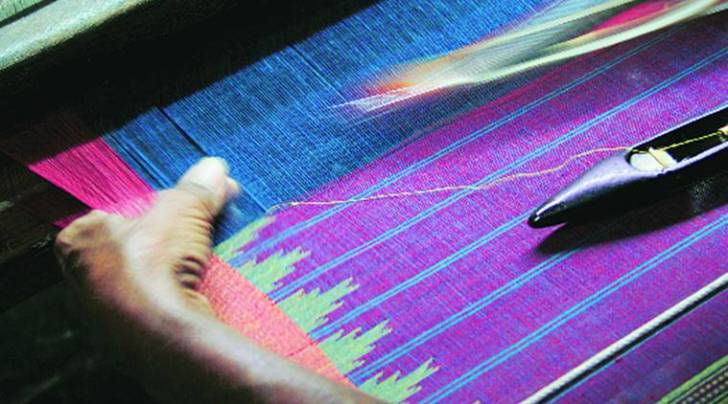One Thread at a Time
The brilliant part of the exhibition is the way it shows a complete loop of activity, from the yarn that’s woven on the charkha to the final yardage. It’s a hint at the ecologically efficient rhythm of working on the primal thread that holds human history.

A photo shows three shuttle weaving from Ponduru in Andhra Pradesh
Yellappa, a master dyer of natural indigo from Uravakonda, crouches over a vat filled with bluish-black liquid, stirring its innards. The dung, dirt and straw flooring takes on an orange hue, providing the composition an earthy frame. This is one of the many photographs at India International Centre, where “Many Yarns of the Cotton Handloom Story”, an art exhibition about handloom weaves by Dastkar Andhra (DA), is on display.
Printed on everyday woven thaan, the photographs by Pankaj Sekhsaria and the DA team tell the story from field to fabric. Tools of warp makers and warp sizers, bobbin winders, and cloth by weavers make their way into this exhibition. To make it multi-sensorial, the organisers encourage you to feel the texture of the fabric, hold the yarn, smell the dye and listen to the sounds of the hand and power looms. “Handloom has always been about the senses. If you feel the sliver of handspun cotton done on the ambar charka, you will see they are texturally different. The only way to know natural indigo-dyed fabric from synthetic indigo-dyed fabric is by smell. The vat-dyed cloth gives out a strong smell that does not leave the yarn even in the fabric stage, while the synthetic indigo product will not have any special odour,” says Latha Tummuru, who heads design and marketing at Dastkar Andhra Marketing Association and is the curator of the exhibition.
The highlight of the show are the specimens of synthetic indigo powder and the natural indigo cakes. A photograph of an indigo dyer smelling the yarn tells of how the natural dye is tested. That it smells of rotting vegetables is a surprise for those who have never really come this close to the dye.
DA has been in the business of cotton handloom weaving for over 25 years, trained artisans in natural dyes and strengthened weavers cooperatives to make it a viable profession. India has nearly 44 lakh weaver families, which also proves we have the largest number of looms in the world. Known to be the largest industry after agriculture in rural India, the Indian textile industry has a lot of untapped potential that emerges in an exhibition such as this.
“Our strength is our diversity,” says Uzramma, founder member, DA. “Across the country, our weaves are so unique, it is the envy of the world. And yet, we fail to recognise it. There are so many stories to be told. Humanity is inherently looking for connection and each woven fabric has a story to tell. An exhibition like this shows how much vitality there is. Just imagine the sense of self-worth a weaver will have when he sees this. We don’t value that enough,” she says.
DA has trained numerous medium-skilled weavers to take on the profession.“We work with medium-skilled weavers for the simple reason that they are the majority in the industry and, if we don’t give them work, they’ll end up being security guards. Over the last 20 years as a clothing designer I’ve seen how we’ve grown disconnected with the process and the way of life that weaving presents. Therefore, the unawareness of the process leads to the appreciation of only the end product,” says Tummuru.
The brilliant part of the exhibition is the way it shows a complete loop of activity, from the yarn that’s woven on the charkha to the final yardage. It’s a hint at the ecologically efficient rhythm of working on the primal thread that holds human history
together.
together.
The exhibition at IIC closes today






















No hay comentarios:
Publicar un comentario